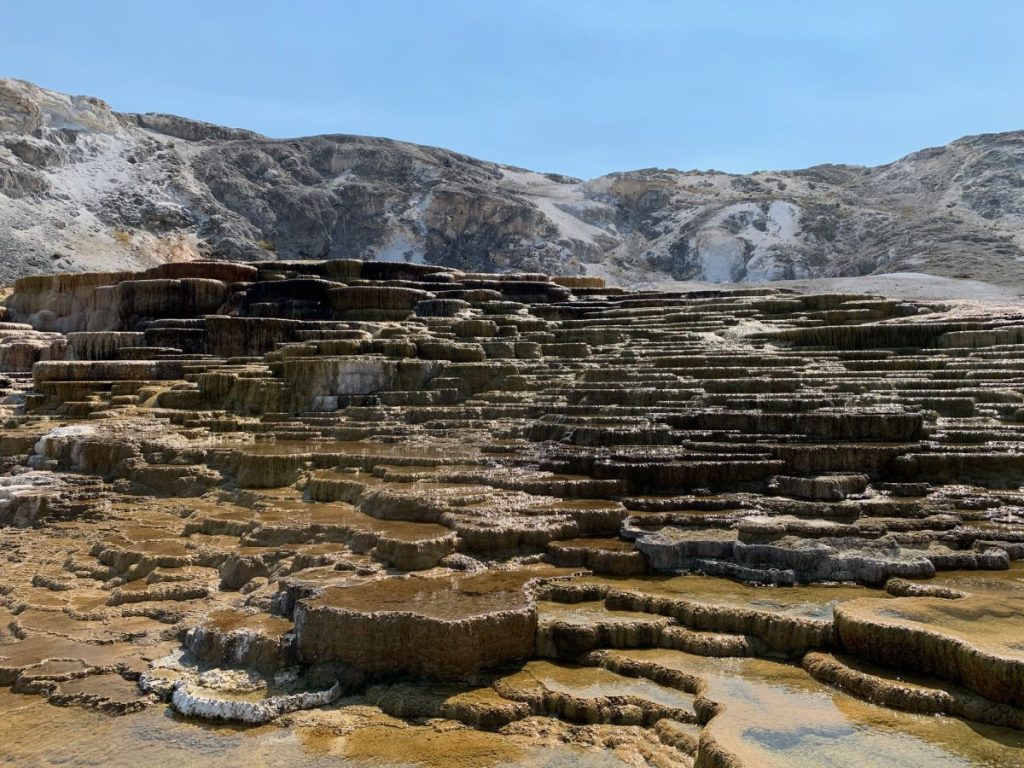Take in These Sublime Yellowstone Geothermal Features
There are plenty of good reasons that Yellowstone was designated America’s first national park, and perhaps chief among them is the incredible assortment of geothermal features scattered throughout the park.
In fact, Yellowstone is home to over 10,000 hydrothermal features, including more than 500 geysers.
Here are the five types of Yellowstone geothermal features you can see inside the park:
- Hot Springs: Geothermally heated pools of water.
- Geysers: Constricted hot springs that periodically erupt as pressure builds up beneath the ground.
- Mudpots: Hot springs, typically lacking water, so acidic that they dissolve adjacent rock.
- Travertine Terraces: Hot springs that deposite calcite, rising through limestone to form terraces.
- Fumaroles: Steam vents with no water.
There are so many incredible geothermal features in Yellowstone, a visitor could easily spend their entire trip at these sites alone.
But to help you see the most iconic Yellowstone geothermal features without consuming your entire visit, we’ve put together this list of hot springs, geysers, and other features every hydrothermal enthusiast should see.
Old Faithful Geyser
Yes, Old Faithful is world-famous and one of the busiest spots in the entire park, but it’s at the top of this list because if you don’t stop to see it erupt, you’ll regret it.
Plus, the historic Old Faithful Inn is well worth a stop.
The advantage of Old Faithful is, well, it’s faithfulness. No, it’s not quite as reliable as the city bus, but this geyser is more or less on time, so it’s easy to stop, watch, and continue on with your travels.
Seeing that plume of water and steam spew into the sky on a clear day is an experience every Yellowstone visitor will remember for years to come. And, because it’s known worldwide as the most famous of all Yellowstone geothermal features, seeing this geyser for yourself is a rewarding experience.
While you wait, you can take a stoll along the boardwalk and enjoy the geyser from different angles.
Odds are you’ll have a fantastic time visiting Old Faithful. But, surprising as it may be, this geyser apparently isn’t for everyone. If you want a good laugh, check out these wild 1-star reviews people left online about their visit to Old Faithful.
Mammoth Hot Springs
Mammoth Hot Springs is an example of the travertine terraces mentioned at the beginning of this article.
As water rises through the limestone, it brings dissolved calcium carbonate to the surface, which is deposited to form travertine. Travertine is the white, chalky rock you see in the terraces at Mammoth.
These terraces are visually intriguing, but are also interesting because the rapid deposition of calcium carbonate means that these features change rapidly.
In fact, the Shoshone and Bannock people used minerals from Mammoth Hot Springs for white paint for hundreds of years.
The boardwalks that run through the terraces at Mammoth are an absolute must for visitors that want to experience one of the most iconic Yellowstone geothermal features.
Grand Prismatic Spring
This is the largest hot spring in the park and one of the most recognizable Yellowstone geothermal features.
The thermophiles — microscopic organisms that thrive in the superheated, acidic environment created by geothermal activity in Yellowstone — group together by the trillions and give sites like Grand Prismatic their jaw-dropping colors.
Located in the Midway Geyser Basin, Grand Prismatic is another high-traffic spot, so be prepared to exercise patience as you try to find a parking spot, especially between 10am and 6pm.
Make sure you’ve got at least a quality phone camera with you, because you’ll want to take a ton of photos when you visit Grand Prismatic Spring.
Norris Geyser Basin
Alright, you caught us — Norris isn’t a geothermal feature, per se. It’s a home to a collection of some of the best, and most accessible, Yellowstone geothermal features.
According to the National Park Service, the Norris Geyser Basin shows signs of geothermal features dating back some 115,000 years.
As you traverse the boardwalk, you’ll see all kinds of geothermal features in Norris. Among the most popular are Echinus Geyser and Steamboat Geyser.
In fact, Steamboat Geyser is the tallest geyser in the world. When it erupts, it sends water some 300-400 feet into the air.
These major eruptions often occur years apart, so you shouldn’t try to plan your Yellowstone visit around Steamboat Geyser. However, it has been far more active since 2018, and you have decent odds of catching a minor eruption.
Even the minor Steamboat eruptions are fantastic. They range from 10-40 feet high.
Take Care Near Yellowstone Geothermal Features
Know that the water in and around Yellowstone geothermal features is extremely hot and extremely acidic. Coming into contact with this water can cause serious injury or death.
Over 20 people have died after falling or wading into Yellowstone hot springs. Hot springs are the most deadly natural feature in Yellowstone, having killed more visitors than any other.
When visiting geothermal areas in Yellowstone, stay on the boardwalk. Keep an eye on your kids with you to ensure they do the same. Do not let your children run on the boardwalks.
Pets are not allowed in thermal areas.
For more safety tips, check out our guide to being a responsible Yellowstone visitor.










